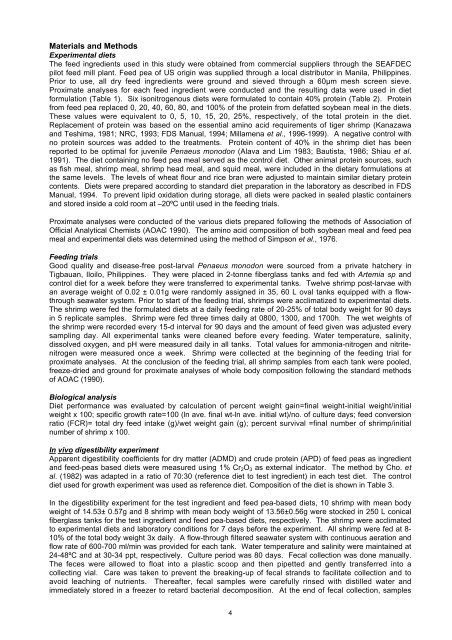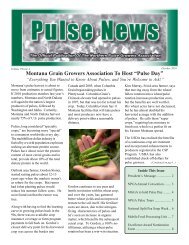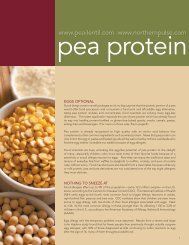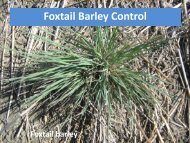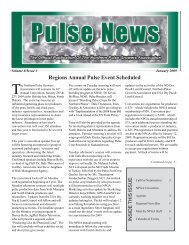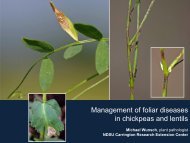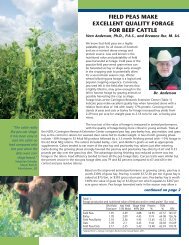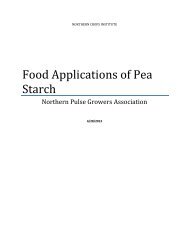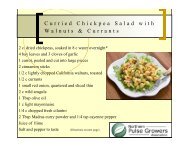Feed Peas in diets for shrimp tilapia and milkfish - Northern Pulse ...
Feed Peas in diets for shrimp tilapia and milkfish - Northern Pulse ...
Feed Peas in diets for shrimp tilapia and milkfish - Northern Pulse ...
Create successful ePaper yourself
Turn your PDF publications into a flip-book with our unique Google optimized e-Paper software.
Materials <strong>and</strong> MethodsExperimental <strong>diets</strong>The feed <strong>in</strong>gredients used <strong>in</strong> this study were obta<strong>in</strong>ed from commercial suppliers through the SEAFDECpilot feed mill plant. <strong>Feed</strong> pea of US orig<strong>in</strong> was supplied through a local distributor <strong>in</strong> Manila, Philipp<strong>in</strong>es.Prior to use, all dry feed <strong>in</strong>gredients were ground <strong>and</strong> sieved through a 60µm mesh screen sieve.Proximate analyses <strong>for</strong> each feed <strong>in</strong>gredient were conducted <strong>and</strong> the result<strong>in</strong>g data were used <strong>in</strong> diet<strong>for</strong>mulation (Table 1). Six isonitrogenous <strong>diets</strong> were <strong>for</strong>mulated to conta<strong>in</strong> 40% prote<strong>in</strong> (Table 2). Prote<strong>in</strong>from feed pea replaced 0, 20, 40, 60, 80, <strong>and</strong> 100% of the prote<strong>in</strong> from defatted soybean meal <strong>in</strong> the <strong>diets</strong>.These values were equivalent to 0, 5, 10, 15, 20, 25%, respectively, of the total prote<strong>in</strong> <strong>in</strong> the diet.Replacement of prote<strong>in</strong> was based on the essential am<strong>in</strong>o acid requirements of tiger <strong>shrimp</strong> (Kanazawa<strong>and</strong> Teshima, 1981; NRC, 1993; FDS Manual, 1994; Millamena et al., 1996-1999). A negative control withno prote<strong>in</strong> sources was added to the treatments. Prote<strong>in</strong> content of 40% <strong>in</strong> the <strong>shrimp</strong> diet has beenreported to be optimal <strong>for</strong> juvenile Penaeus monodon (Alava <strong>and</strong> Lim 1983; Bautista, 1986; Shiau et al.1991). The diet conta<strong>in</strong><strong>in</strong>g no feed pea meal served as the control diet. Other animal prote<strong>in</strong> sources, suchas fish meal, <strong>shrimp</strong> meal, <strong>shrimp</strong> head meal, <strong>and</strong> squid meal, were <strong>in</strong>cluded <strong>in</strong> the dietary <strong>for</strong>mulations atthe same levels. The levels of wheat flour <strong>and</strong> rice bran were adjusted to ma<strong>in</strong>ta<strong>in</strong> similar dietary prote<strong>in</strong>contents. Diets were prepared accord<strong>in</strong>g to st<strong>and</strong>ard diet preparation <strong>in</strong> the laboratory as described <strong>in</strong> FDSManual, 1994. To prevent lipid oxidation dur<strong>in</strong>g storage, all <strong>diets</strong> were packed <strong>in</strong> sealed plastic conta<strong>in</strong>ers<strong>and</strong> stored <strong>in</strong>side a cold room at –20ºC until used <strong>in</strong> the feed<strong>in</strong>g trials.Proximate analyses were conducted of the various <strong>diets</strong> prepared follow<strong>in</strong>g the methods of Association ofOfficial Analytical Chemists (AOAC 1990). The am<strong>in</strong>o acid composition of both soybean meal <strong>and</strong> feed peameal <strong>and</strong> experimental <strong>diets</strong> was determ<strong>in</strong>ed us<strong>in</strong>g the method of Simpson et al., 1976.<strong>Feed</strong><strong>in</strong>g trialsGood quality <strong>and</strong> disease-free post-larval Penaeus monodon were sourced from a private hatchery <strong>in</strong>Tigbauan, Iloilo, Philipp<strong>in</strong>es. They were placed <strong>in</strong> 2-tonne fiberglass tanks <strong>and</strong> fed with Artemia sp <strong>and</strong>control diet <strong>for</strong> a week be<strong>for</strong>e they were transferred to experimental tanks. Twelve <strong>shrimp</strong> post-larvae withan average weight of 0.02 ± 0.01g were r<strong>and</strong>omly assigned <strong>in</strong> 35, 60 L oval tanks equipped with a flowthroughseawater system. Prior to start of the feed<strong>in</strong>g trial, <strong>shrimp</strong>s were acclimatized to experimental <strong>diets</strong>.The <strong>shrimp</strong> were fed the <strong>for</strong>mulated <strong>diets</strong> at a daily feed<strong>in</strong>g rate of 20-25% of total body weight <strong>for</strong> 90 days<strong>in</strong> 5 replicate samples. Shrimp were fed three times daily at 0800, 1300, <strong>and</strong> 1700h. The wet weights ofthe <strong>shrimp</strong> were recorded every 15-d <strong>in</strong>terval <strong>for</strong> 90 days <strong>and</strong> the amount of feed given was adjusted everysampl<strong>in</strong>g day. All experimental tanks were cleaned be<strong>for</strong>e every feed<strong>in</strong>g. Water temperature, sal<strong>in</strong>ity,dissolved oxygen, <strong>and</strong> pH were measured daily <strong>in</strong> all tanks. Total values <strong>for</strong> ammonia-nitrogen <strong>and</strong> nitritenitrogenwere measured once a week. Shrimp were collected at the beg<strong>in</strong>n<strong>in</strong>g of the feed<strong>in</strong>g trial <strong>for</strong>proximate analyses. At the conclusion of the feed<strong>in</strong>g trial, all <strong>shrimp</strong> samples from each tank were pooled,freeze-dried <strong>and</strong> ground <strong>for</strong> proximate analyses of whole body composition follow<strong>in</strong>g the st<strong>and</strong>ard methodsof AOAC (1990).Biological analysisDiet per<strong>for</strong>mance was evaluated by calculation of percent weight ga<strong>in</strong>=f<strong>in</strong>al weight-<strong>in</strong>itial weight/<strong>in</strong>itialweight x 100; specific growth rate=100 (ln ave. f<strong>in</strong>al wt-ln ave. <strong>in</strong>itial wt)/no. of culture days; feed conversionratio (FCR)= total dry feed <strong>in</strong>take (g)/wet weight ga<strong>in</strong> (g); percent survival =f<strong>in</strong>al number of <strong>shrimp</strong>/<strong>in</strong>itialnumber of <strong>shrimp</strong> x 100.In vivo digestibility experimentApparent digestibility coefficients <strong>for</strong> dry matter (ADMD) <strong>and</strong> crude prote<strong>in</strong> (APD) of feed peas as <strong>in</strong>gredient<strong>and</strong> feed-peas based <strong>diets</strong> were measured us<strong>in</strong>g 1% Cr 2 O 3 as external <strong>in</strong>dicator. The method by Cho. etal. (1982) was adapted <strong>in</strong> a ratio of 70:30 (reference diet to test <strong>in</strong>gredient) <strong>in</strong> each test diet. The controldiet used <strong>for</strong> growth experiment was used as reference diet. Composition of the diet is shown <strong>in</strong> Table 3.In the digestibility experiment <strong>for</strong> the test <strong>in</strong>gredient <strong>and</strong> feed pea-based <strong>diets</strong>, 10 <strong>shrimp</strong> with mean bodyweight of 14.53± 0.57g <strong>and</strong> 8 <strong>shrimp</strong> with mean body weight of 13.56±0.56g were stocked <strong>in</strong> 250 L conicalfiberglass tanks <strong>for</strong> the test <strong>in</strong>gredient <strong>and</strong> feed pea-based <strong>diets</strong>, respectively. The <strong>shrimp</strong> were acclimatedto experimental <strong>diets</strong> <strong>and</strong> laboratory conditions <strong>for</strong> 7 days be<strong>for</strong>e the experiment. All <strong>shrimp</strong> were fed at 8-10% of the total body weight 3x daily. A flow-through filtered seawater system with cont<strong>in</strong>uous aeration <strong>and</strong>flow rate of 600-700 ml/m<strong>in</strong> was provided <strong>for</strong> each tank. Water temperature <strong>and</strong> sal<strong>in</strong>ity were ma<strong>in</strong>ta<strong>in</strong>ed at24-48ºC <strong>and</strong> at 30-34 ppt, respectively. Culture period was 80 days. Fecal collection was done manually.The feces were allowed to float <strong>in</strong>to a plastic scoop <strong>and</strong> then pipetted <strong>and</strong> gently transferred <strong>in</strong>to acollect<strong>in</strong>g vial. Care was taken to prevent the break<strong>in</strong>g-up of fecal str<strong>and</strong>s to facilitate collection <strong>and</strong> toavoid leach<strong>in</strong>g of nutrients. Thereafter, fecal samples were carefully r<strong>in</strong>sed with distilled water <strong>and</strong>immediately stored <strong>in</strong> a freezer to retard bacterial decomposition. At the end of fecal collection, samples4


